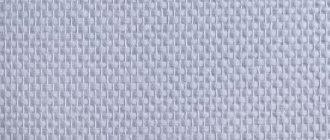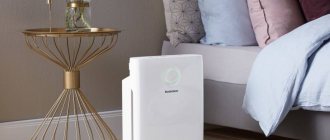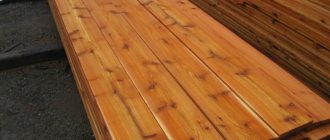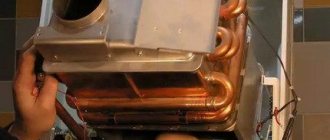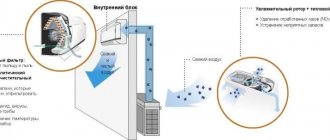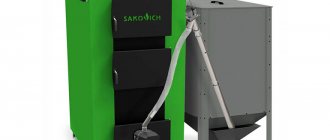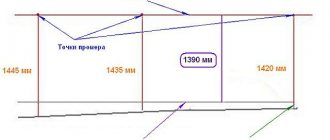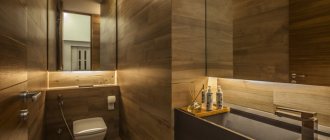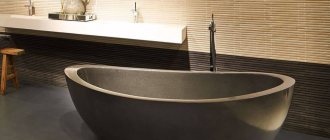23.11.2020
With the beginning of the heating season, sales of humidifiers - climate control equipment that increases the level of indoor air humidity - traditionally increase. In this article we will talk about the reasons for the popularity of such equipment and consider the differences between humidifiers and air washers. We will also talk about a device that is an important addition to these devices.
The demand for humidifiers and air washers is not accidental: they help reduce the incidence of acute respiratory infections and flu, their work has a beneficial effect on well-being, and improves the condition of allergy sufferers due to dust removal. You don’t have to listen to Dr. Komarovsky’s lectures to know that normal air humidity in an apartment is one of the important measures for the prevention of respiratory diseases in children. And according to his recommendation - regular ventilation of the premises.
The reason is obvious - during the heating season, the average air humidity in apartments is 15-25%, while the norm is 45-50%. For comparison, an air humidity level of 20% is typical for deserts, where there may be no rain for decades.
Principle of operation, types, advantages and disadvantages
Modern air purifiers can not only clean the air of dust, but also humidify and ionize it. The main element of the device is the filter. The quality of air purification depends on the material of its manufacture and design. The operating principle of the devices is simple. Air is drawn into them and passed through several stages of filters.
After passing through the purifier, the air is cleared of suspended dust. Dust settled on the surface of furniture, floors and walls must be removed using a vacuum cleaner and wet cleaning. Together with dust, the devices are capable of purifying the air from carbon monoxide and pollen.
For allergy and asthma sufferers, installing air purifiers in apartments and houses can be a good prevention of exacerbation of diseases.
For this category of people, it is better to purchase devices with UV radiation or an ozonizer. Most modern models are equipped with filters treated with photocatalysts. These are special substances that destroy harmful bacteria.
According to the international classification, all air purifiers are usually divided into three groups according to the degree of purification:
- coarse (capable of holding parts larger than 10 microns: wool, fluff);
- fine (remove particles larger than 1 micron from the air):
- highly effective (catch up to 99-100% of airborne microparticles).
The latter type of devices is recommended for use in medical institutions.
Humidifiers: operating principle and technical characteristics
This climate control technology is divided according to the principle of water evaporation into three types of devices:
- conventional (evaporation is carried out using the “cold” method, that is, by passing air through cartridges or meshes moistened with water);
- ultrasonic (evaporate water using an ultrasonic emitter, crushing it into small particles);
- steam (classical method of evaporating water by heating it).
Each of the listed types of humidifiers has its own characteristics, advantages and disadvantages.
Photocatalytic
Devices of this type are considered universal. The design is equipped with an ultraviolet lamp and a catalyst that acts as a filter. It is capable of capturing even the smallest particles of street and household dust, lint, etc. The porous glass used in their production eliminates the problem of frequent filter replacement. This provides savings on consumables.
Photocatalytic air purifiers
Titanium dioxide is applied to the surface of the filters used in models of this type. It transmits and absorbs sunlight well. Passing through the filter, they trigger oxidative processes that decompose organic compounds in the air. This reaction occurs with the release of moisture and carbon dioxide.
Expert opinion
Chebatkov Maxim Pavlovich
Specialist in household appliances and their repair
Photocatalytic devices, in addition to purifying the air, also humidify it.
Advantages:
- Frequent filter replacement is not required;
- effective air purification from odors of smoke, burning, toxic gases, fumes of household chemicals;
- the ability to destroy bacteria, fungi, mold spores and viruses;
- low power consumption;
- silent operation.
Main disadvantage:
- not all models effectively cope with cleaning the air from dust, hair, dust mites, and epidermal particles.
How are humidifiers different from air washers?
Air washers are similar in design to traditional humidifiers. The difference is that humidifiers only saturate the air with moisture, while sinks moisturize, clean and disinfect it. The versatility of sinks is one of their advantages.
To combat bacteria and viruses, sinks may have a built-in UV emitter. The ionizer fights dust, fur and other allergens that may be in the air. Air washers can also be equipped with photocatalytic filters, and the most expensive models are equipped with HEPA filters, which ensure the retention of up to 99% of contaminants.
AIC CF8410
AIC CF8410
The model is designed for air purification in a room up to 35 sq.m. The design has 5 stages of air purification, is equipped with a HEPA filter, an ultraviolet lamp and an air ionizer. The operation of the device is monitored using indicators located on the front panel of the device.
Advantages:
- high degree of air purification and disinfection;
- air ionization;
- presence of a timer;
- stylish modern design.
Flaws:
- floor installation;
- high noise level at 2 and 3 speeds.
Disinfection in the presence of people
Air recirculators (bactericidal lamps)
A bactericidal air recirculator is a kind of housing with a built-in UV lamp, which provides a disinfecting effect. Plus there is a fan that circulates air through the device.
Since the circulation process is repeated many times, hence the name - recirculator. We will not dwell on the comparison of bactericidal recirculators of different models.
Since there are no fundamental differences in the design of models from different manufacturers. They differ only in the number and power of installed lamps.
The efficiency of the recirculator depends on:
Firstly, it depends on the power of the UV lamp. The more powerful the radiation, the more serious damage microbes receive when passing through the device;
Secondly, on the performance of the fan. The higher it is, the greater the volume of air passes through the disinfectant per hour.
At the same time, when choosing an anti-virus recirculator, it is better to choose a model with a high radiation intensity and high fan performance.
Therefore, when choosing which air recirculator to buy, you need to pay attention to only 2 indicators:
- radiation intensity (number of UV lamps and their power);
- fan performance;
- recommended area.
It is important to adhere to the recommended area, since depending on the radiation power, each model is designed to treat a room of a certain area. If you install the device on a smaller area, you will not get the effect. A device that is too powerful will produce too much ozone, which is an inevitable byproduct of ultraviolet radiation.
Plasma air purifiers
An effective and safe way to disinfect air in rooms with people constantly present in them. The first generation of such devices is known as electrostatic air purifiers. These include the widely known Super Plus Turbo in Russia.
Plasma purifiers are the next stage in the development of this technology. They generate a much more powerful electrostatic discharge, the cleaning ability of which is tens and hundreds of times greater than the efficiency of a classic electrostat.
Plasma cleaning is one of the most effective technologies that allows you to instantly clean the air of any impurities and destroy all known microorganisms.
The disinfecting and cleansing effect is based on the unique strength of ozone. As we have already noted, this gas is a powerful natural oxidizer and disinfectant, which, upon completion of cleaning, completely disintegrates into oxygen.
The plasma cleaning unit consists of 2 parts:
1. The air ionization unit is an ionizing and ozonizing electrode of negative polarity. It is important that depending on the material, design and voltage applied to the electrode, the amount of ozone generated and the concentration of the resulting ions may be different.
Powerful Electrostatic Air Purifier Filter AIC XJ-4100
2. Electrostatic block - metal plates that are collecting electrodes of positive polarity. The cleaning ability of the device from large dust, pollen, soot, etc. depends on the area of these plates.
Mechanical pollutants contained in the air and passing through the ionizing unit acquire a negative charge. Because of this, they stick to the positively charged metal plates. This is how the process of cleaning the air from dust, allergens and other mechanical pollutants occurs.
In this case, disinfection and purification of air from volatile chemical compounds occurs due to ozonation, which is always formed during operation of the ionizing unit.
Thus, plasma purifiers provide a triple effect:
- Air purification from mechanical particles due to adhesion to precipitation plates;
- Purification from volatile chemical compounds due to oxidation with ozone;
- Disinfection is also due to the action of ozone.
Plasma and electrostatic cleaners-ionizers AIrComfort
A large group of air purifiers based on electrostatic and photocatalytic purification. More details about the models can be found in the AirComfort air purifiers section.
These are affordable devices, many of which demonstrate high efficiency in both air purification and disinfection processes.
Most AirComfort models are electrostatic and plasma cleaners with high-quality ionization units. Plus, there are serious blocks of settling plates here, as well as silent fans.
This manufacturer's product range includes small, extremely simple electrostatic water purifiers.
So are modern plasma purifiers with good plasma generation units, efficient fans and large-area precipitation plates.
Plus, AirComfort offers models based on photocatalytic cleaning: 8410, 8500, 8200, 8005. Moreover, they are equipped with LED UV lamps with a range of 365 nm, “sharpened” for the destruction of viruses. What is important for the prevention of coronavirus.
An additional effect of these devices is good ionization of the air - giving oxygen molecules a negative charge. Ionized air is good for health. Since oxygen absorption in this case increases by 20%. That is, ionization does not increase the amount of oxygen in the air, but improves its absorption by our body by 20%.
Therefore, being in a room with negatively charged ions reduces fatigue and speeds up recovery processes. In other words, it is easier to work and rest better in ionized air. In nature, we observe this effect in a coniferous forest, in the mountains, next to a waterfall. And the use of a household air ionizer allows you to create similar conditions in a closed room.
Electrostatic cleaners Super plus
Inexpensive devices made in Russia. Super Plus is a classic electrostatic air purifier, the main effect of which is to clean the air from dust contaminants.
As with any electrostat, a by-product of the ionization unit is the release of ozone. Which provides a disinfecting and additional cleansing effect.
Super Plus Turbo is a more powerful model, Super Plus Eco is a smaller one. The main disadvantage of these devices is the lack of a fan.
Therefore, here the movement of air through the device is carried out only due to the “ionic wind” effect. However, air performance is in any case low. Because of this, the operating efficiency of these devices is noticeably inferior to models with built-in fans (for example, AIC).
Sharp plasma air purifiers and humidifiers
Another device from the family of plasma air purifiers. Sharp's patented Plasmacluster technology is nothing less than a good plasma generator. Hence the high efficiency of the device in air purification and disinfection.
As for air ionization, this device also creates good concentrations of light negative ions. Light oxygen ions are the highest quality and easily digestible. Whether the ionizer generates light ions or not depends on the specific design of the ionization unit. And here it is done at the highest level.
Plus, Sharp ionizer purifiers have an additional air humidification function. Moreover, it is based on the most comfortable principle of cold evaporation. Inside there is a humidifying disk that rotates in a tray of water and optimally humidifies the air in a natural way.
Plus, air pollution sensors, a digital display and a modern body design. So, due to the combination of air purification, ionization and humidification, Sharp is a good device for an apartment.
Daikin air purifiers
These are air purifiers that operate on two air purification and sterilization technologies at once: plasma purification and photocatalysis. The key element is the Flash Streamer unit. Despite its unusual name, this element is a conventional comb ionizing unit aimed at generating ozone.
Plus, like any other electrostatic unit, Flash Streamer imparts a negative charge to dust particles and other mechanical air pollutants. Due to this, it becomes possible to filter them out, or rather “stick” them to a positively contaminated surface. In this case, the role of the settling surface is performed by a replaceable roll or pleated filter.
An additional purification step is photocatalysis. In older Daikin MC707 models, in addition to a roll-on photocatalytic filter coated with titanium dioxide powder, there was a UV lamp that activated the photocatalysis process and additionally disinfected the air.
In the new Daikin MC70 and MCK75 models, the photocatalytic cleaning unit is designed differently. Instead of titanium dioxide, a titanium apatite photocatalytic filter is used here, which works without ultraviolet radiation. Accordingly, there is no UV lamp here. Instead of an ultraviolet lamp, the photocatalysis process here activates the Flash Streamer plasma generation unit.
Thus, Daikin purifiers have 2 fundamental blocks:
- Flash Streamer streamer unit. Releases ozone and thereby destroys microorganisms and volatile chemicals;
- replaceable double-sided pleated filter. The first side (white) acts as a positively charged precipitator for mechanical contaminants, the particles of which, after passing through the ionizing block, receive a negative charge and then adhere to the surface of the filter. The second side (blue) is a titanium apatite filter, the photocatalysis process in which is triggered by ions from the Flash Streamer.
By combining these two technologies, a high degree of cleaning and disinfection is achieved. Especially taking into account the very high air productivity - one such purifier is capable of passing through up to 430 cubic meters per hour.
True, the main role in the process of air purification and disinfection here is still played by the Flash Streamer plasma generation unit. At such high air flow rates, the photocatalytic stage only performs an additional role (odor removal).
By the way, treatment with catechin, an extract from tea tree leaves, as well as an immunoglobulin filter are stated as an additional disinfection step. But this is just a marketing ploy, nothing more. You should not count on a serious effect from them.
All the devices discussed above are designed for round-the-clock operation in rooms with people. And therefore they have no restrictions for use in an apartment or office. Turn it on and get clean and disinfected air without any restrictions.
ATMOS Vent-1103
ATMOS Vent-1103
The model has a multi-stage air purification system. Designed for installation in rooms up to 110 square meters. m. The device has a compact vertical shape with a top panel arrangement of control buttons. The design is equipped with sound and light indexing and can operate in various speed modes. An additional function is air aromatization.
Advantages:
- attractive design;
- high degree of air purification;
- ionization;
- compactness.
Flaws:
- increased noise level when operating at speed 2;
- A lot of dust accumulates on the pre-filter.
Air purifier equipment
When purchasing an air purifier, you should pay special attention to the following characteristics and equipment:
- Noise level. This is especially important if the device is equipped with a fan, since the device itself does not make any sounds;
- Preset timer;
- Remote control;
- Sensor indicating filter contamination;
- An indicator that scans the air condition; based on its indicators, you can determine when the purifier can be turned off/on.
Adsorption
Adsorption air purifiers
The operating principle of this type of air purifier is based on the physical absorption of gas molecules. They are considered the best fighters against unpleasant odors. The quality of air purification is directly related to the volume of the carbon filter. They need to be changed periodically.
Some models of absorption purifiers are equipped with mechanical filters. They serve to pre-clean the air. This prevents premature clogging of the carbon filters.
It is recommended to install devices of this type not only in residential premises, but also in kitchen hoods. They belong to fine filters.
Advantages:
- good capture capacity of volatile particles larger than 40 AU;
- high efficiency of air purification from aromatic compounds and carbons.
Flaws:
- are not effective in cleaning the air from viruses and bacteria;
- require periodic filter replacement;
- cannot be used in rooms with high air humidity.
Air disinfection technologies
Ultraviolet radiation
The most famous technology is disinfection using ultraviolet light. Almost everyone has heard that a UV lamp destroys pathogens. This is exactly how bactericidal recirculators work - the only devices from the group of disinfectants that are familiar to many.
Manufacturers offer quite a few models of recirculators, but in essence they all represent a kind of housing with a built-in fan and an ultraviolet lamp.
Ultraviolet rays (UV, UV) are electromagnetic radiation of the optical (visible) spectrum with a wavelength range from 100 to 400 nm. Due to the fact that this spectrum is visible to the human eye, we clearly define the operation of a UV lamp as a visible white-violet glow.
In contrast to, for example, X-ray radiation, which also belongs to the category of electromagnetic radiation. But the wavelength is located outside the perception zone of the human eye and therefore is invisible to us.
Depending on the wavelength, the ultraviolet spectrum is divided into three groups:
- Ultraviolet A, long-wave range - wavelength 315-400 nm;
- Ultraviolet B, mid-wave range - wavelength 280-315 nm;
- Ultraviolet C, short wavelength - wavelength 100-280 nm.
At the same time, ultrafiltration of different spectrums has different effects on living microorganisms.
For example, short-wave UV-C radiation in the range of 205-315 nm has the most powerful bactericidal effect. This is what the bactericidal effect of ultraviolet lamps is based on.
The fact is that rays of this spectrum damage the DNA of the cell nucleus of a microorganism.
Scientifically speaking, UV causes destructive-modifying damage to the RNA and DNA of cells.
These changes gradually accumulate and over time, damaged cells become unable to divide. Which leads them to extinction in the first and subsequent generations.
At the same time, different types of microorganisms are susceptible to different ranges of the ultraviolet spectrum.
It is known that bacteria are most sensitive to UV light. To destroy them, soft short-wave UV-C radiation (200-300 nm) is sufficient. Then, in descending order of sensitivity, come fungi, yeast, bacterial spores and viruses.
Viruses are the most resistant to ultraviolet radiation. To cause noticeable damage to virus virions, ultraviolet radiation in a more severe range is needed - UV-B or even UV-A.
Research results indicate that the longer the wavelength, the more destructive the effect of ultraviolet light on the virus. Most studies have concluded that UV with a wavelength of 295 to 340 nanometers has the greatest effect on viruses.
For example, this is confirmed by a study of the effectiveness of Alpha pulsed ultraviolet installations conducted at the Research Institute of Virology named after. DI. Ivanovsky Ministry of Health of the Russian Federation.
This study compared the effects on viruses of conventional germicidal lamps in the 254 range and a more intense xenon UV source with a broad spectrum of radiation 190-400 nm. The results showed that the long-wave radiation source was significantly more effective than commonly used germicidal lamps.
Another relationship that scientists have discovered is that the larger the virus, the more susceptible it is to ultraviolet radiation .
At the same time, there are a number of viruses that are generally immune to UV. For example, the RNA virus IPNV of the genus Aquabirnavirus and AHNV (family Nodaviridae). Primarily due to their very small sizes (diameter 60 nm and 30 nm, respectively).
While the most susceptible to ultraviolet radiation are large herpesviruses, the diameter of the virion together with the envelope reaches 140-200 nm.
Since the size of the coronavirus is close to 100 nm, it is quite susceptible to the destructive effects of ultraviolet radiation.
This susceptibility has already been confirmed by scientists - according to Wikipedia, coronavirus is highly susceptible to ultraviolet radiation and temperature.
In addition, in June 2022, a large UV lamp manufacturer, Signify, conducted studies that demonstrated the high efficiency of mid-range 254 nm UV rays. for coronavirus. According to the official statement on the Signify website, 99% of virions of the SARS-CoV-2 coronavirus, known as COVID-19, die when exposed to UV-C (ultraviolet C - wavelength from 100 to 280 nm).
True, this effect is achieved when:
- a fairly high radiation intensity - 5 millijoules per 1 sq. see surfaces;
- with continuous exposure to ultraviolet light on the virus for 6-25 seconds.
Scientists noted that after exposure to UV-C ultraviolet radiation at such a concentration, the coronavirus was completely deactivated. And it was not detected in the test material after 6 seconds of exposure to ultraviolet radiation at the specified dosage.
These data are also confirmed by a large-scale study by the Center for Radiological Research at Columbia University, New York. The purpose of this study was to examine the effect of the softer 222 nm UV range. for viruses. Since the long-wave range is more dangerous and can cause burns if it comes into direct contact with human skin.
And the overall result is this. Of course, long-wave UV-B radiation has a more destructive effect on the virus. However, even soft ultraviolet in the 222 nm range. causes damage to RNA and DNA of viruses. Therefore, given high radiation intensity and long contact times, short-wave ultraviolet UV-C is also destructive to viruses.
It follows from this that conventional bactericidal lamps in the 254 nm range are, in principle, capable of having a destructive effect, including on the coronavirus.
It is also clear that the higher the total radiation power of UV lamps, the higher their antiviral activity .
The main problem is that when air gets inside the recirculator, it is exposed to UV irradiation for only 1-2 seconds. Exactly what damage the virus receives during such a short time of contact with a UV lamp remains unknown. At least, in publicly available sources there is not a single mention of such a study.
In addition, all air recirculators are closed type devices. That is, here UV exposure is carried out only on the air passing directly through the device. Therefore, for a good effect of disinfecting a room, you need a device that would process the entire volume of air in the room 2-3 times per hour.
Taking into account these studies, it is possible to talk about 100% effectiveness of UV against viruses only if open-type irradiators are used. Unlike the recirculator, the UV lamp in the irradiator is not hidden inside the housing. Therefore, its impact extends over a large volume. And, most importantly, UV rays affect the air and surfaces not for 1-2 seconds, but much longer.
However, due to the high intensity of UV radiation, such disinfectants cannot be used in the presence of people. Therefore, open-type irradiators are used mainly in medicine. And only in the absence of people.
So UV irradiators and recirculators are not very suitable for disinfecting premises. Read more about this in the article “Disinfection of indoor air with ultraviolet light and ozone: comparison of effectiveness.”
By the way, this article explains why a purifier-disinfectant disinfects the air MORE EFFECTIVELY THAN A RECIRCULATOR. The reason for this is that microorganisms are much easier to destroy by trapping them on internal filters.
So let's summarize.
- A bactericidal UV lamp in the 254 nm range can have a detrimental effect not only on bacteria, but also on viruses.
- The maximum antiviral effect is achieved when using an open-type air irradiator. Due to prolonged exposure to ultraviolet light.
- A closed air recirculator is also effective against viruses. But only under the condition of high radiation intensity (lamp power). As well as fan performance sufficient to process the entire volume of air 2-3 times in 1 hour.
- In addition, the air recirculator must be turned on 24 hours a day.
Air ozonation
This technology is much less familiar to the average person. Although the disinfecting effect of ozone is 3-5 times higher than that of ultraviolet radiation.
Ozone INSTANTLY destroys not only bacteria, but also ALL KNOWN viruses and fungi.
Moreover, it does this MUCH more effectively than chlorine and any other known disinfectants.
Due to the fact that ozone has a destructive-oxidizing effect on cell walls and cytoplasm, completely destroying their structure.
Therefore, there are very few forms of microorganisms resistant to ozone. The interaction of ozone with living microflora ends with the mechanical destruction of the cell, whatever it is: viruses, bacteria, spores, fungi, algae, etc.
It is important that after disinfection with ozone no compounds or odors arise. The only thing that remains after the action of ozone is oxygen. After all, after the oxidation process is completed, ozone turns back into oxygen. Due to the fact that ozone has such a valuable property of self-disintegration, its overdose is impossible.
Ozone is a gas that is formed when an electrical discharge, as well as ultraviolet light, acts on oxygen.
By the way, this is why when operating mercury UV lamps (and this is the vast majority of them), a small amount of ozone is also formed. This odor can be felt when the UV disinfectant is used for a long time.
Ozone is well known to each of us by the smell that appears after a thunderstorm.
The electrostatic discharge that occurs during lightning forms this gas, the presence of which we sense through the characteristic “smell of a thunderstorm.”
When introduced into a water or air environment, ozone performs four actions:
- bactericidal;
- deodorizing;
- disinfectant;
- oxidative.
Due to its very high oxidizing and disinfecting ability, it is actively used for water purification (ozonation of water) and air.
Benefits of ozone disinfection
The use of ozone has important advantages over chlorine:
- Due to its use in small doses, it does not produce side effects. Does not pollute the environment, but at the same time is a powerful disinfectant.
- Allows you to organize sanitary treatment and disinfection of any surfaces, materials, including water and air.
- One molecule of ozone is equivalent in action to 3,000 to 10,000 molecules of chlorine; it kills pathogenic microorganisms 3,500 times faster than a chlorine molecule.
For example, the polio virus dies with a residual ozone value of 0.45 lg/l after 2 minutes, and with a dose of chlorine of 1 lg/l only after 3 hours. The effect of ozone on spores, bacteria and generally any pathogenic microorganisms is 300-600 times stronger, than chlorine. Ozonation is also highly effective for water purification. For example, when the color of water decreases (the development of algae and phytoplankton in it), ozone is needed 2.5 times less than chlorine.
Important advantages of ozonation compared to UV radiation:
- Completely destroys any microflora and pollutants;
- Provides instant effect. Not a gradual weakening, as in UV, but the complete destruction of molecules;
- Disinfects not only the air, but also surfaces;
- Affects all known types of viruses, fungal spores and bacteria without exception.
Difficulties of using ozone for disinfection and disinfection:
- Ozone is a poisonous gas not only for microorganisms, but also for humans. Therefore, it is important to maintain safe concentrations here. For example, in household electrostatic and plasma air purifiers, the emission of ozone is clearly calculated in order to prevent exceeding the maximum permissible concentration in a room of a certain area.
- Large concentrations of ozone (which, for example, are generated by air ozonizers) are permissible for disinfecting premises only without the presence of people.
So ozone is the most effective way to instantly disinfect any environment. There are 2 types of devices that generate ozone:
- Air ozonizers that create large concentrations of this gas. Therefore, in living rooms they are turned on only for a short time;
- Electrostatic and plasma air purifiers that emit safe concentrations of ozone. Such devices are designed for continuous operation in the presence of people.
Read below to learn how to properly use ozone-emitting devices.
Photocatalysis
A little-known method of deep air purification from any organic and inorganic pollutants. The photocatalytic filter consists of 2 elements: titanium dioxide applied to the surface and a UV lamp.
The ultraviolet radiation of the lamp activates titanium dioxide, turning it into a powerful catalyst for oxidation processes. Oxidation is a natural process that always occurs in an air environment containing oxygen. It’s just that in this case the intensity of oxidation processes increases hundreds of times, approaching in its effects the cleansing properties of a fire flame.
Therefore, in its effect, photocatalysis resembles ozonation. Since additional oxidation also occurs here, i.e. decomposition of any substance, organic and inorganic, into harmless components (water, carbon dioxide).
Due to this, the microorganism’s cell not only loses its ability to reproduce, as when exposed to ultraviolet radiation, but is completely destroyed.
Please note that a UV lamp is needed here to activate the catalyst in the form of titanium dioxide. Therefore, UV lamps of a completely different spectrum are used here than in bactericidal emitters - 320-400 nm.
By the way, this spectrum provides an additional antiviral effect.
Therefore, photocatalytic cleaning can destroy any microorganisms and even elusive pollutants, which are volatile chemicals. Including:
- viruses, bacteria, fungi, spores, mold;
- tobacco smoke, including tars contained in tobacco smoke;
- phenol, formaldehyde, and other harmful fumes from furniture and finishing materials;
- any odors;
- environmental pollution from car engines, enterprises, etc.
An important difference between photocatalysis and ozonation is the area of influence . Due to the fact that ozone is a volatile gas, its disinfecting effect extends to the entire volume of air, as well as to all materials and surfaces in the room. While the oxidative effect of a photocatalytic filter applies only to the air that passes directly through the device - the same as when exposed to a UV lamp.
Thus, in order to ensure complete destruction of microorganisms due to UV rays or the photocatalysis process, it is necessary to repeatedly pass air through the device.
Difficulties in using photocatalytic purification
In addition, photocatalytic filters are difficult to manufacture and use.
First, you need a large surface area of titanium dioxide that will be in contact with the air passing through the device.
Secondly, to start photocatalysis you need a UV lamp of the correct range, preferably LED, not mercury.
Thirdly, the photocatalytic purification process is effective only with small volumes of air passing through the filter.
Therefore, photocatalytic filters built into wall-mounted air conditioners are generally meaningless. Since the split system pumps 300-400 cubic meters. m. per hour.
And effective cleaning of such volumes can be organized only with the help of a plasma (electrostatic) filter based on ozonation.
There are 2 devices on sale in which photocatalytic cleaning works:
- Japanese Daikin air purifiers;
- Russian air purifiers Aerolife.
The first Japanese-made devices are very expensive and not available to everyone.
The latter, although they have a very high-quality photocatalytic filter inside, are far from perfect in everything else (the appearance of the case and the built-in fan).
At the same time, Aerolife makes excellent industrial installations for disinfection in medical institutions, cleaning in smoking rooms, and restaurants. It’s just that they apparently don’t get around to developing modern household models.
In principle, the claimed photocatalytic filter can be found in many household air purifiers. But their area is so small that there is no need to talk about any noticeable effect. Therefore, they are often called deodorizing rather than photocatalytic.
However, everything is individual and you need to look at what other technologies are used in the device. It’s good if there is also plasma (electrostatic) cleaning. Then, even if the photocatalyst is of little use, it will compensate for the plasma generation unit.
The HEPA filter does not disinfect the air!
Previously, it would never have occurred to anyone to claim that a HEPA filter is capable of purifying the air from bacteria and viruses. This is simply the result of the wild excitement that arose due to the coronavirus epidemic.
When normal appliances become in short supply, unscrupulous sellers try to smuggle in what is lying around in the warehouse.
What is a HEPA filter? This is simply a non-woven material that traps mechanical dust particles from the air.
That is, HEPA works the same way as a medical mask - when passing through the filter material, microorganisms simply “get stuck” in the pores.
At the same time, they continue to live. Their activities are not disrupted in any way. Let's say that the viruses there die naturally after some time.
But bacteria and fungi stuck in the pores can generally begin to multiply and subsequently enter the air in even greater quantities. This will depend on the HEPA filter itself (porosity, material) and air conditions (temperature, humidity).
It’s another matter if the HEPA filter works in conjunction with electrostatic or photocatalytic air purification. In this case, HEPA traps polluting particles, and photocatalyst or ozone disinfects it.
So, let's move on to a review of devices that can be used for disinfection. Moreover, both in the presence of a person and in rooms without people.
Xiaomi Mi Air Purifier 2S
Xiaomi Mi Air Purifier 2S
The model is equipped with a laser sensor that is sensitive to dust particles larger than 0.3 microns. The device screen has lighting with adjustable brightness. The model's productivity is 310 cubic meters per hour. Designed for installation in residential premises with an area of 23-25 square meters. m. The model can be controlled through a computer application. The device filter is three-layer.
Advantages:
- attractive design;
- good degree of air purification;
- possibility of remote control;
- silent operation;
- ease of filter replacement.
Flaws:
- high cost of consumables;
- not effective in heavily polluted environments.
Price categories
Budget air purifiers , which have average power and are suitable for cleaning a small area, do not have additional functions.
But, in general, they do their job well; they can cost from one and a half to 5-6 thousand rubles.
Devices in the mid-price category are suitable for frequent use , have decent characteristics and are chosen most often.
It is devices for 8-15 thousand rubles that are usually found in apartments.
Premium class products are suitable for heavily polluted premises , including industrial buildings, private houses, and large apartments.
Need to know! Their cost varies from 15 to 100 thousand rubles and is determined by power, efficiency and the number of available functions and modes.
If the device will be used with average frequency in an ordinary apartment, it is better to focus on options in the middle price category.
Polaris PPA 5068i
The model is designed to be placed on a horizontal surface. Installed in residential premises with an area of up to 35 square meters. m. The design has a three-level cleaning system. There is an air pre-filter and HEPA. The degree of filter contamination is shown on the indicator. The model has an air ionizer function. The device is controlled by touch. There is a screen backlight.
Polaris PPA 5068i
Advantages:
- low cost:
- stylish design.
Flaws:
- does not cope well with severe air pollution;
- There are problems with purchasing original replacement filters.
Best Air Purifier Manufacturers
The modern market offers consumers a large selection of air purifiers created by manufacturers from around the world. How to choose an air purifier for an apartment? To avoid mistakes, you should definitely pay attention to devices produced by popular and sought-after manufacturers. Today these include:
- AIC (inexpensive and stylish cleaners).
- Fanline (it is believed that this manufacturer offers its customers the best device equipment at a low cost).
- Atmos-Aqua (Russian manufacturer offering devices capable of serving a large area).
- Boneco (offers inexpensive “air washers” with excellent functionality and low noise levels during operation).
- NeoClima (well-equipped devices offered at reasonable prices).
- Electrolux (devices with good functionality, ideal for use in children's rooms).
Fine mechanical cleaning
The second name for HEPA devices. Devices that are simple in design are in great demand among buyers. HEPA can be either a separate device or part of a more advanced model. The operating principle of the devices is based on sucking air under pressure and passing it through several cleaning filters.
Expert opinion
Chebatkov Maxim Pavlovich
Specialist in household appliances and their repair
The efficiency of such devices for collecting small debris is 99%. The device filters cope well with suspended air particles with a size of up to 0.3 microns.
The group of these particles includes all known allergens, mites and mold spores. The most common filter material is paper and its derivatives. Some manufacturers use synthetic materials to make filters.
Advantages:
- low cost;
- ease of maintenance;
- reliability in operation.
Flaws:
- insufficient filter strength;
- does not cope with all types of air pollution.
What parameters should I pay attention to?
Choosing an air purifier may seem easier at first glance than it actually is.
You should pay attention not only to the filter type, but also to some other parameters.
Room area
In the description of each device there is such a parameter as the volume of air purified.
The device is designed for a certain area, so you should not underestimate or overestimate it.
- If the air purifier is to operate in only one room , you should choose a product that closely matches the area of the room and the characteristics of the device. Such devices are cheaper, more compact and have limited capabilities.
- If the device will be placed in one or another room, you need to focus on the area of the larger of them.
- For very small spaces (for example, a bathroom), a miniature car cleaner is also suitable.
It is worth noting! An air purifier for the entire apartment is a larger and more powerful device.
It can clean up to 50 square meters, and the largest and most expensive ones can clean an even larger area.
Types of pollution
First you need to answer the question for what purpose the device is being purchased.
If “ for prevention ”, so that the room is less dusty and more comfortable to live in, you can take a simpler and cheaper air purifier.
If we are talking about an apartment where people with allergies or asthma live and even the smallest particles (allergens) need to be eliminated, you need to opt for more powerful, effective and expensive purifiers that are equipped with a HEPA or carbon filter.
The capabilities of each device are indicated on the packaging or in the technical data sheet.
Frequency of operation
Stay up to date! The frequency of changing components and cleaning the device depends on the frequency of operation.
So, if the device will work daily without interruption, it is better to choose a replaceable filter , which will need to be changed as it gets dirty (the frequency of replacement is indicated in the operating instructions).
also suitable for daily use.
A device with replaceable filters must have an air ionization function.
If the device is taken for use as needed, for example, once a month, you can take a device with a non-replaceable filter.
It will need to be vacuumed or rinsed under running water after each use.
You should also pay attention to energy consumption: if the device will work constantly, you need to take a low-power air purifier.
Noisy operation
Know! You can take a noisy device if it will be used rarely or only during the daytime when no one is at home.
If there are small children in the apartment who need a lot of sleep, or the work schedules of household members do not coincide, it is important to choose either a device that operates silently or has a “night mode” function.
The quietest are photocalytic air purifiers and ionizers, as well as devices without a fan.
Rough mechanical cleaning
Designed to retain large dust particles. Coarse mechanical filters are rarely used as separate devices. In complex modern devices they solve the problem of preliminary air purification from large particles of debris. This helps to increase the working life of more sensitive filters.
Advantages:
- low cost;
- simplicity of design.
Main disadvantage:
- are able to cope only with large particles of air pollutants.
Choice
When purchasing an air purifier, it is advisable to make the right choice based on its intended purpose.
That is, you first need to decide what needs to be cleaned from.
- Electrostatic cleaner gets rid of dust;
- Photocatalytic or carbon help cope with gas pollution;
- Products equipped with air purity control operate automatically and are also capable of reporting air quality.
When purchasing a purifier, you need to choose a model that can handle the intended volume of air.
It is worth focusing on indicators such as air exchange and serviced area.
The modern market can provide any model of air purifier, designed for any volume of serviced area.
Electrostatic
Otherwise, devices of this type are called ionizing. The operation of the devices is based on the principle of attraction of oppositely polar electrical charges. Dirt particles in the air are passed through an ionizing chamber, in which they receive a “+” charge.
They attract plates with a negative charge. They are easily cleaned from dirt with ordinary soapy water. The efficiency level of this type of air purifier is higher than HEPA. Most often, such devices come complete with carbon filters and an ultraviolet lamp.
Advantages:
- silent operation;
- low energy consumption.
Flaws:
- low productivity;
- high concentrations of ozone produced by devices can be dangerous to humans.
Supply ventilation with built-in air purifier
Many modern ventilation systems are equipped with air purifiers. Installing such a device is a very correct decision, since the air that enters the apartment through the ventilation holes is not always clean - it needs high-quality cleaning from dangerous impurities, dust and dirt particles. Otherwise, people who constantly live indoors have a high risk of developing diseases of the respiratory system, as well as their exacerbation (if they already exist).
To filter out contaminants coming from the street, mainly filters of types G, F, H (E), as well as the most effective type U, which are used in devices used to create and maintain a sterile environment, are installed in the supply ventilation systems.
If we choose a supply air purifier for an apartment, what should we pay attention to first? If you don’t want to buy a useless device, you should pay attention not only to the class of filters, but also to their quantity and resource. It is important to understand that the larger the volume of filter material, the longer and better the device will last. If the instructions supplied by the manufacturer state that the filters should be changed several times a year, then this only indicates that the service life of the material is short - you should refrain from purchasing such a device.
With water filter
Purifiers with water filter
Devices of this type are often called air washing devices. Most models come with air conditioners. The principle of operation is based on sucking in air, imparting a positive charge to contaminated particles and washing them away after adhering to a plate with a negative charge in a special receiver tray.
Advantages:
- high cleaning efficiency;
- high performance;
- big savings on consumables.
Flaws:
- not all types of air pollution are captured;
- It is necessary to constantly monitor the cleanliness of the receiver tray.
Having an air purifier is very important for people with breathing problems
Medical experts unanimously declare that all asthmatics and allergy sufferers should keep an air purification device in their home. This is vitally important for them, because the filter of this particular device is capable of eliminating harmful impurities (pollen, carbon monoxide, dust) from the air that a person breathes, which are stimulants of exacerbation of diseases of the respiratory system.
Moreover, people who have similar problems should not skimp when purchasing an air purifier for their apartment. Reviews from many manufacturers directly state that for people at risk, the ability of the device of the type in question to act as an ionizer and source of UV radiation is especially important.
Doctors say that people suffering from asthma should take the level of humidity in their homes more seriously. That is why they are recommended to purchase devices with a built-in air washing and humidification function.
Some reviews of air purifiers for apartments left by Russians say that these devices work the same as simple air conditioners, as a result of which many claim that there is simply no time to spend money on them. In fact, this is completely wrong, because a primitive air conditioner filter is not capable of retaining particles harmful to the human body. By the way, it is precisely because of the inhalation of these that completely healthy people begin to notice the manifestation of respiratory tract diseases.
Combination devices
Air purifiers of this type include quartz devices. They are equipped with photocatalytic filters, HEPA, used for coarse filtration. Experts recommend using air purifiers of this type for people suffering from allergic diseases and bronchial asthma. The cost of such products is quite high. Regular replacement of consumables also requires certain investments.
Combined air purifiers also include devices with hydro-air filtration and air ionization. They are installed in rooms with increased requirements for air purity. They are capable of not only deep cleaning the air, but also aromatizing it. They alternately perform the functions of air purification, ionization and humidification inherent in the design.
pros
- Purifying the air in an apartment from harmful impurities makes it healthier , even if the consumer lives in a polluted city.
- Removing allergens, pollen, tobacco smoke, and soot from the air makes life much easier for allergy sufferers , this is especially important during periods of exacerbation of the disease.
- Removing bacteria and viruses makes it possible during epidemics to resist the spread of infection and prevent an increase in the number of sick family members.
- Purification with ozonation helps disinfect the air , creating a feeling of freshness, like after a thunderstorm.
- Washing and humidifiers in rooms with low humidity solve this problem, help to avoid various kinds of ailments , irritation of the eyes, the mucous membrane of the upper respiratory tract, and a decrease in the protective functions of the skin and the entire body as a whole.
Ultraviolet based
Multifunctional devices of this type are considered the safest. Along with air purification, they quartz it. They have the highest rate of deep air purification.
The advantages of these devices are:
- possibility of operation in the presence of people;
- no ozone formation during air purification;
- low level of electricity consumption;
- compactness;
- ability to cope with fungal and mold spores.
TOP manufacturing companies
The highest quality devices are produced by both those companies that are widely known all over the world (for example, Tefal, Philips, Polaris), and those that many have not heard of (Ballu, Atmos, Timberk).
The Daikin brand specializes in premium air purifiers created using innovative technologies.
As a rule, devices have a stylish design, a large number of additional functions, and the possibility of remote control, but they are expensive.
The most popular models:
- Daikin MC70LVM;
- Daikin Ururu MCK75JVM K.
The manufacturer Bork has patented a unique Green 360° filter system.
Note! This system consists of an enzyme filter with antibacterial impregnation and a carbon filter with a catalytic element.
Best models:
- BORK A802 RAIN;
- BORK A804;
- BORK A704;
- BORK A503;
- BORK A803.
One of the best well-known manufacturers is Philips . Most often, devices use a HEPA filter, which cleans the air very well.
The Philips AC3256/10 model is in demand with a mode for monitoring the concentration of allergens in the air, a touch control system and light indication of the degree of air pollution.
Panasonic's F-VXK70R air purifier with humidification is one of the best among both its brothers and competitors.
It is equipped with several filters, Green Tea Catechin filter layer with antiviral effect and nanoparticles that attract allergens, viruses and small dust particles.
Questions and answers
Where should air purification devices not be installed?
It is not recommended to install air purifiers on window sills and near heating devices.
Can air purifiers be dangerous to humans?
If you follow the instructions for using the devices, they are completely safe. The large amount of ozone produced by some models poses a danger to human health. It is necessary to control its indicator. You should not stay in the room when most models of devices equipped with ultraviolet lamps are operating. It is necessary to promptly clean the filters from contaminants in order to prevent the proliferation of microbes, bacteria and viruses harmful to humans.
Where can air purifiers be installed?
The devices can be installed in any residential premises, as well as corridors, kitchens and bathrooms. The main thing is that their performance matches the area of the room chosen for their installation.
Can a device installed in one of the rooms purify the air throughout the entire apartment?
Even a high-power air purifier will not be able to clean the air in the entire apartment. It will only clean it in the room in which it is installed.
At what height is it better to install an air purifier in an apartment?
The optimal installation height is considered to be one third of the room height from the floor level. There must be at least 1 meter of free space in front of the device.
Air purification in residential premises is an effective preventive measure to prevent the occurrence of respiratory diseases in humans. Such devices are recommended for installation by people suffering from allergies or bronchial asthma, as well as owners of pets and birds.
Traditional humidifiers: “blow” moisture into the room
Such devices use the principle of natural humidification. A tray equipped with mesh cartridges is inserted into the device body. Water coming from a reservoir inside the device wets the cartridges. When the built-in fan is turned on, an air flow passes through the wet cartridges, transferring moisture into the environment.
Traditional humidifiers partially perform the functions of air washing, since during their operation some of the dust from the room atmosphere settles in water. Another advantage is the natural regulation of humidity in the room - even if you forget to turn off the device, the humidity will not rise above normal levels. With this evaporation method, the air simply does not absorb excess moisture.
This device also has disadvantages - the noise of the fan during operation, as well as the need to clean and disinfect the trays. If this is not done, plaque will constantly form on them - colonies of bacteria for which humidity and heat are ideal conditions for reproduction.
Air aromatization and hygrometers
Not all sinks have air aromatization, and this is more of a nice bonus than an important parameter. If the aromatherapy function is needed, it is necessary to clarify how it is implemented in the model of interest.
In Stadler Form sinks, aroma oils are poured into a special compartment. In car washes from other manufacturers, oil can be added directly to the water tank. In models where aromatization is not provided, oil can damage the device.
Convenient water filling and tank design
Water is poured into the sink from above or into a removable tank. It is more convenient to fill from above, but the removable tank is easier to wash and dry: take it to the bathroom, open it, rinse with soap and return it to its place. They often have convenient carrying handles.
The problem with cheap devices with removable tanks is a loud gurgling sound when water from the tank pours into the working pan. In high-quality models, this is solved by thick plastic that absorbs sound. In Stadler Form sinks, gurgling noise does not wake up owners in the middle of the night.
The clear plastic container on the left is the George air washer tank. Clever Swiss design - the air hole doubles as a tank handle
Tank volume and time it lasts
To make the sink convenient to use, the size of the water tank must match the evaporation rate. If the sink produces 550 ml of water per hour and its tank is 2.5 liters, it will have to be refilled every 4.5 hours. During the day this may not be critical, but adding water in the middle of the night is inconvenient.

